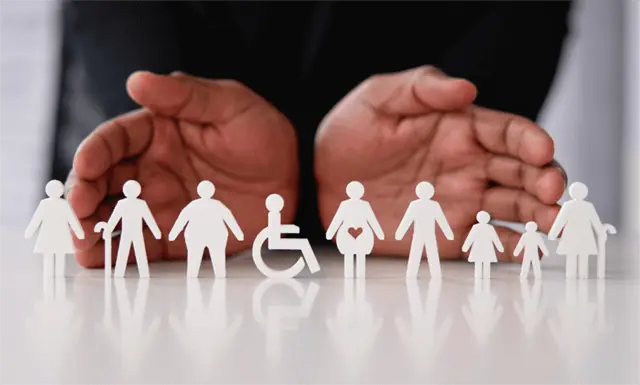🛡️ What Is Safeguarding and Why Is It Important?
Safeguarding is a vital process that protects people—especially vulnerable children and adults—from abuse, neglect, exploitation, and harm. It ensures that individuals are free to live with dignity, security, and independence, no matter their age or background. In the UK, safeguarding and child protection are legally enforced across healthcare, education, and social care settings. This guide explains what safeguarding means, why safeguarding is essential, the safeguarding legislation in the UK, and how organisations and individuals play a role in protecting those at risk.
Whether you’re a healthcare worker, educator, carer, parent, or community volunteer, understanding safeguarding is essential. Professionals can benefit from taking structured training such as the Safeguarding Children Training or Safeguarding Vulnerable Adults Training to meet statutory duties and ensure full compliance with safeguarding responsibilities.
🛡️ What Does Safeguarding Mean?
Safeguarding refers to the legal and practical measures used to protect individuals’ health, well-being, and human rights, ensuring they live free from harm. It involves proactive steps such as identifying potential risks, taking early action, and creating systems and policies to prevent abuse, neglect, or exploitation.
Safeguarding is an all-encompassing term that includes child protection, adult safeguarding, digital safety, and community protection. It applies to individuals across all age groups, including children, elderly people, and those with physical or mental disabilities. While child protection is a crucial aspect of safeguarding, the broader term also includes safeguarding adults who may lack the capacity or resources to protect themselves.
If you’re looking to work in roles that involve safeguarding responsibilities, completing a Level 3 Diploma in Health and Social Care or a Level 3 Diploma in Nursing Assistant Complete Training can provide essential foundational knowledge and practical insight into best practices.
Why Is Safeguarding Important in the UK?
Safeguarding matters because it protects the fundamental right of individuals to feel safe and supported. When safeguarding measures are effective, they prevent serious harm and long-term trauma, reduce the risk of abuse, and ensure timely intervention before issues escalate.
Without effective safeguarding:
🚫 Children may experience physical, emotional, or sexual abuse and lack safe environments for growth
🚫 Adults in care may be exposed to neglect, exploitation, or mistreatment
🚫 Individuals with disabilities or mental health issues may be overlooked or denied essential support
According to NHS and Department for Education regulations, safeguarding policies, safeguarding responsibilities, and regular training are essential for recognising risk and taking timely, effective action. In management and leadership roles, safeguarding knowledge is also vital for policy design, legal compliance, and ensuring safe organisational cultures. Those aiming for such roles may benefit from the Level 4 Diploma in Health and Social Care Management, which covers leadership, legislation, and safeguarding implementation.
🏥 Key Sectors That Rely on Safeguarding
1. Safeguarding in Healthcare Healthcare professionals are often the first to identify signs of abuse or neglect. NHS staff are trained to take swift, proportionate action to protect at-risk patients. Safeguarding in healthcare also involves respecting patient autonomy, confidentiality, and ensuring support plans are in place for vulnerable individuals.
2. Safeguarding in Education Children spend a large portion of their lives in educational settings, making schools a frontline for safeguarding. Safeguarding policies must be embedded in school operations, including anti-bullying procedures, staff vetting, and student mental health support. The presence of a Designated Safeguarding Lead (DSL) ensures that any child protection concerns are swiftly addressed.
3. Safeguarding in Social Care Safeguarding in social care settings focuses on older adults and individuals with care needs. The Care Act 2014 requires local authorities to ensure that care environments are safe and respectful. Safeguarding practices include background checks for care workers, person-centred care planning, and regular reviews of individual safety.
4. Digital Safeguarding The internet has introduced new risks, including online grooming, cyberbullying, misinformation, and digital exploitation. Digital safeguarding is now a core responsibility in education and care services. Organisations must implement safe browsing practices, privacy controls, and clear reporting systems for digital harm.
🧭 Key Principles of Safeguarding in the UK

The UK government has established a clear set of safeguarding principles to guide professionals and organisations in implementing effective safeguarding strategies. These principles are intended to be applied across all sectors and settings to create a standardised and ethical approach to protecting vulnerable individuals:
🙌 Empowerment:
Encourage individuals to participate actively in decisions about their care and support. Empowerment means giving people control over their own lives, enabling them to make informed choices and express their views confidently.
🛑 Prevention:
Prioritise early intervention and education to prevent harm before it happens. Prevention includes training staff, raising public awareness, and implementing policies and procedures that reduce the risk of abuse or neglect occurring in the first place.
⚖️ Proportionality:
Ensure that any safeguarding action taken is appropriate to the level of risk involved. Interventions should be the least intrusive necessary to protect a person’s rights and safety, avoiding unnecessary restrictions on their freedom.
🛡️ Protection:
Provide targeted support for individuals in the greatest need. This includes taking action when someone is at risk of harm and ensuring that appropriate safeguarding procedures and services are in place to keep them safe.
🤝 Partnership:
Promote collaboration between professionals, organisations, families, and communities to ensure the best outcomes. Effective safeguarding relies on trust, information sharing, and mutual understanding between multiple agencies working toward the same goal.
📋 Accountability:
Maintain clear roles, responsibilities, and reporting structures for all safeguarding activities. Accountability ensures that organisations remain transparent, and professionals are held responsible for protecting the welfare of those in their care.
These principles form the foundation of all professional safeguarding training in the UK and are embedded in policies outlined in legislation such as the Children Act, the Care Act, and Working Together to Safeguard Children. They are also covered comprehensively in courses like the Level 3 Diploma in Health and Social Care and Safeguarding Children Training, helping learners build the knowledge and confidence to uphold high safeguarding standards.
Major Safeguarding Legislation in the UK
The Children Act 1989 & 2004: These landmark pieces of legislation form the cornerstone of child safeguarding in the UK. The acts establish the duty of local authorities, courts, and other agencies to prioritise the welfare of children in all decisions. The legislation outlines clear frameworks for early intervention, child protection plans, and multi-agency support.
The Care Act 2014: This act is pivotal for adult safeguarding. It places a statutory duty on local authorities to prevent abuse and neglect among adults with care and support needs. The Act promotes person-centred care, introduces safeguarding enquiries, and mandates the creation of Safeguarding Adults Boards to oversee care standards.
The Safeguarding Vulnerable Groups Act 2006: Introduced to protect vulnerable people from unsuitable individuals, this act established the legal framework for the Disclosure and Barring Service (DBS). It ensures that those working with children or vulnerable adults are subject to rigorous background checks and not listed on the barred persons register.
Working Together to Safeguard Children (2018): This guidance outlines how professionals and agencies should collaborate to safeguard children. It emphasises the importance of early help, information sharing, and coordinated intervention across health, education, and social services.
Keeping Children Safe in Education (2021): This statutory guidance sets out schools’ and colleges’ responsibilities to safeguard and promote the welfare of pupils. It covers topics like safer recruitment, handling allegations, and the importance of Designated Safeguarding Leads in educational settings.
The Mental Capacity Act 2005: This act ensures that adults who may lack the capacity to make decisions are supported and protected. It sets out how decisions should be made on behalf of someone else and ensures their best interests are always prioritised. It plays a vital role in safeguarding adults with cognitive impairments.
Roles and Responsibilities in Safeguarding
Designated Safeguarding Leads (DSLs): DSLs are appointed within organisations like schools, hospitals, and care settings. They take the lead on managing safeguarding concerns, ensuring procedures are followed correctly, and liaising with external authorities like social services or the police.
Employees and Volunteers: Every individual working with children or vulnerable adults has a legal and moral duty to uphold safeguarding practices. This includes knowing how to identify signs of abuse, reporting concerns appropriately, and adhering to the organisation’s safeguarding policies.
Parents and Caregivers: As primary guardians, parents and caregivers play a crucial role in safeguarding. They must be vigilant for signs of abuse or neglect and understand the safeguarding measures in place at their child’s school, healthcare provider, or care setting.
Local Authorities: These bodies are responsible for conducting safeguarding assessments, coordinating multi-agency responses, and ensuring compliance with national safeguarding legislation. They also lead local safeguarding boards and provide resources and training across sectors.
🎯 Tailored Safeguarding for Different Groups
🧒 Safeguarding for Children: Children need specially designed safeguarding approaches that address their developmental stage and vulnerabilities. Policies must include safeguarding training for teachers, clear reporting mechanisms, mental health support, and age-appropriate communication about safety.
👴 Safeguarding for Elderly Adults: Older adults may face abuse in the form of neglect, financial exploitation, or physical harm. Safeguarding measures include regular wellbeing checks, staff DBS vetting, person-centred care plans, and family involvement in care reviews.
♿ Safeguarding for People with Disabilities: People with disabilities are more vulnerable to exploitation and abuse due to communication challenges or dependency on carers. Safeguarding in this area must include adapted communication tools, specially trained staff, and support frameworks that empower independence and consent.
Challenges and Barriers to Effective Safeguarding
Lack of Safeguarding Training: Many professionals lack the depth of training required to identify subtle or non-physical signs of abuse. Continuous professional development is essential to keep safeguarding knowledge current.
Cultural Sensitivities: Cultural norms, language barriers, or community stigma may prevent individuals from reporting abuse or seeking help. Organisations must adopt inclusive approaches and provide culturally competent support.
Resource Limitations: Understaffed organisations and underfunded services often struggle to maintain consistent safeguarding practices. This can result in missed signs of abuse and insufficient intervention.
Information Sharing: While GDPR and privacy concerns are vital, they can sometimes prevent timely sharing of information between agencies. Clear policies and legal understanding are essential to ensure safety while respecting data protection laws.
Overcoming Safeguarding Challenges
Mandatory Safeguarding Training: Regular training sessions tailored to specific roles can empower staff and volunteers to act confidently when concerns arise.
Multi-Agency Collaboration: Encouraging open communication and partnerships between police, NHS, education providers, and social care teams ensures a joined-up response.
Public Awareness Campaigns: Promoting the importance of safeguarding within communities helps individuals recognise signs of abuse and understand how to report concerns.
Use of Technology: Safeguarding software, centralised reporting tools, and digital monitoring systems can improve incident tracking, case management, and early intervention.
Safeguarding in the Digital Age
Digital safeguarding includes protecting people online from threats such as:
Cyberbullying: Online harassment, especially among children and teenagers, can lead to serious emotional and psychological harm.
Grooming and Sexual Exploitation: Predators use digital platforms to manipulate and exploit individuals, especially vulnerable young people.
Radicalisation: Online forums and content can expose individuals to extremist ideologies, increasing the risk of terrorism and hate crimes.
Financial Scams: Vulnerable adults and elderly individuals are frequent targets of online scams, leading to financial abuse and exploitation.
Inappropriate Content Exposure: Children and young people may encounter violent, explicit, or harmful content without protective filters in place.
Safeguarding strategies in the digital world must include age-appropriate e-safety policies, digital literacy education, monitoring software, and parental controls to create a safer online experience.
The Future of Safeguarding in the UK
The safeguarding landscape in the UK continues to evolve in response to societal, technological, and legislative changes. Key trends include:
-
Greater Use of AI: Artificial intelligence is being used to identify safeguarding risks such as online grooming, abuse indicators, and behavioural patterns in vulnerable individuals.
-
More Personalised Safeguarding Plans: Tailored support plans are becoming the norm, taking into account an individual’s age, background, health needs, and personal circumstances.
-
Mental Health Integration: Recognising the connection between mental well-being and safeguarding is critical. Future safeguarding strategies will focus on early mental health support and trauma-informed care.
-
Policy Adaptation: With rising challenges such as climate migration, refugee integration, and increasing digital threats, safeguarding policies must remain adaptable and inclusive to meet diverse and emerging needs.
FAQs
What is safeguarding and why is it important?
Safeguarding refers to protecting vulnerable individuals from harm, abuse, or neglect. It is essential for ensuring their safety, dignity, and well-being.
What are the 5 aims of safeguarding?
The main aims are: Protection, Prevention, Proportionality, Empowerment, and Partnership.
What is child safeguarding?
Child safeguarding focuses on protecting children from harm and creating safe environments for their development.
Who is responsible for safeguarding?
Safeguarding is everyone’s responsibility, but designated leads, local authorities, and professionals in health, education, and social care have statutory duties.
Conclusion
Safeguarding is more than a policy; it is a culture of protection, care, accountability, and legal responsibility. By understanding safeguarding roles, safeguarding legislation, and safeguarding strategies, we contribute to a safer society for everyone, particularly the most vulnerable among us.
Need safeguarding training for your team? Explore our CPD-accredited safeguarding courses or enrol in a Safeguarding Vulnerable Adults Training or Safeguarding Children Training course today. Looking to build a career in health and social care? Discover our Level 3 Diploma in Health and Social Care, Nursing Assistant Diploma, or Level 4 Diploma in Health and Social Care Management.





 " alt="10 Must-Know User Experience Design Tips for Better Products" />
" alt="10 Must-Know User Experience Design Tips for Better Products" />
 " alt="What Can You Do With a Level 3 Diploma in Health and Social Care?" />
" alt="What Can You Do With a Level 3 Diploma in Health and Social Care?" />
 " alt="Health & Social Care Qualifications: Your Most Asked Questions, Answered" />
" alt="Health & Social Care Qualifications: Your Most Asked Questions, Answered" />

